Åland Islands
Template:Infobox State/Maintenance/NAME-German

![]()
Åland [![]()
![]() ˈoːland], also Landskapet Åland (Finnish Ahvenanmaa, also Ahvenanmaan maakunta, in German official language Ålandinseln), is a region of Finland endowed with extensive political autonomy. It consists of the group of islands of the same name in the northern Baltic Sea at the entrance to the Gulf of Bothnia between Sweden and the Finnish mainland. Swedish is the only official language of the region, which, as a result of a 1921 League of Nations decision, is part of Finland as a demilitarized zone but administers its internal affairs largely autonomously. Certain political and economic rights are also available to Finnish citizens on a limited basis. Today, the islands' economy is dominated by tourism and shipping. The latter is favored by special tax arrangements that allow tax-free purchases when trading with Åland.
ˈoːland], also Landskapet Åland (Finnish Ahvenanmaa, also Ahvenanmaan maakunta, in German official language Ålandinseln), is a region of Finland endowed with extensive political autonomy. It consists of the group of islands of the same name in the northern Baltic Sea at the entrance to the Gulf of Bothnia between Sweden and the Finnish mainland. Swedish is the only official language of the region, which, as a result of a 1921 League of Nations decision, is part of Finland as a demilitarized zone but administers its internal affairs largely autonomously. Certain political and economic rights are also available to Finnish citizens on a limited basis. Today, the islands' economy is dominated by tourism and shipping. The latter is favored by special tax arrangements that allow tax-free purchases when trading with Åland.
Geography
General
The archipelago consists of over 6700 islands and skerries and forms an archipelago at the southern entrance of the Gulf of Bothnia in the northern Baltic Sea. Åland is about 40 km from the Swedish coast and 15 km from the Finnish coast. The main island, Fasta Åland, with about 90% of the population, is located in the west, 40 km from the Swedish coast and 100 km from the Finnish coast.
The islands have a total land area of 1552.38 km². Including the water areas of the Baltic Sea, the region reaches a size of 13,517 km². The total number of islands is 6757, if the minimum size of an island is 0.25 ha. The total population of 30,074 people distributed over 60 islands results in a population density of 18.4 inhabitants/km².
Åland is a relatively flat archipelago. The highest mountain is the Orrdalsklint in the north of Fasta Åland (municipality of Saltvik) with 129 m height.
Geology
The Åland Islands are mostly composed of metamorphic and igneous rocks, which often appear as bedrock. They are of Precambrian age (about 1.6 billion years) and belong to the Baltic Shield. Especially in the eastern part of the archipelago gneiss is present. On the main island and in its surroundings mostly granites are found. Well known by geologists is the reddish granite variety Rapakiwi, which occurs on the islands and is also found very often in northern Germany as glacial till.
The landscape was shaped by the glaciations of the Ice Age. Round hummock landscapes and archipelagos are typical. During the last ice age, the land was completely pushed below the water level by the ice masses, so that after the glaciers melted, the Åland Islands were almost completely covered by water. For about 13,000 years, the land has been gradually rising out of the sea, starting with Åland's highest point, Orrdalsklint. Over time, the land continued to rise and more and more islands formed. This process continues to this day: Åland rises from the sea at a rate of about seven millimeters per year.
Where marine sediments (mostly fine sands and silts) could be deposited in greater thickness (several meters), agriculture is possible after the postglacial land uplift. The areas where the glaciers deposited sediments of low thickness on the rocks during the melting process can also be used for agriculture.
Climate
The climate on Åland is temperate compared to the Swedish and Finnish mainland due to its island location in the Baltic Sea. The Baltic Sea warms the cold northeast winds in winter and cools the hot southeast winds in summer. Annual precipitation averages 541 mm per year, which is lower than on the Swedish and Finnish mainland.
The average annual temperature is 5.5 degrees Celsius. The highest temperature ever measured in Åland was 31.3 degrees Celsius, and the lowest -32.4 degrees Celsius. The average values for the individual months of the year from 1971 to 2000 can be found in the climate table below.
| Climate table for Åland
Source: Finnish Meteorological Institute, Meteorological Yearbook 2003, Years 1971-2000 | |||||||||||||||||||||||||||||||||||||||||||||||||||||||||||||||||||||||||||||||||||||||||||||||||||||||||||||||||||||||||||||||||||||||||||||||||||||||||||||||||||||
Flora and fauna
Åland belongs to the boreal coniferous forest vegetation zone. However, in addition to the predominant fir and spruce species, there are also numerous deciduous trees, especially oaks, ash, elm, maple and linden. Many species of orchids also grow on the islands, most of which belong to the fifty or so protected plants.
Åland is home to 25 species of mammals, including many rodents, but also red deer and roe deer. Due to the sea location and the relatively mild climate, there is a richer bird life than on the Finnish mainland. More than 130 bird species breed on the islands, including endangered water birds such as the Scaup. The white-tailed eagle, which was virtually extinct throughout Finland in the mid-1970s, can be found in large numbers in Åland following successful conservation and reintroduction efforts. Apart from the hunting game, almost all of Åland's animals are protected.
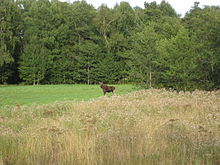
Forest, meadow and elk on Kumlinge.
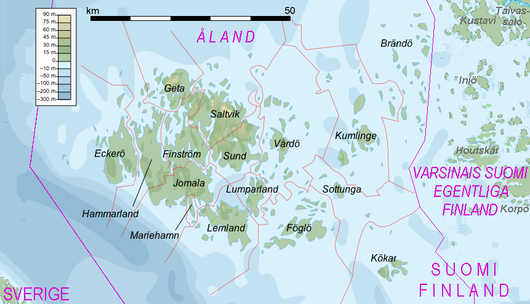
Municipalities in the Åland Islands; the archipelago consists of 6757 islands, 60 of which are inhabited.
Population
Åland's population has grown slowly but steadily since 1970. Whereas 20,666 people lived on the islands in 1970, the total at the end of 2014 was 28,916, a growth of about one percent per year during this period. The population growth comes mainly from residents born in the rest of Finland or abroad. In 1970, they accounted for about 20 percent; today, they account for about 35 percent.
Language
See also: Languages in Åland
The only official language of Åland is Swedish, according to Section 36 (1) and (2) of the Self-Government Act. The vast majority of Åland's population, currently 88.3% (as of the end of 2014), claim Swedish as their mother tongue. However, this proportion is declining slightly: in 1990, it was still 94.5%.
The Swedish dialect spoken in Åland, Ålandic (åländska), is closer to the imperial Swedish spoken in Sweden than to the Finnish Swedish spoken by the Swedish-speaking minority in Finland.
Even within Ålandic there are still some different dialects. For example, the inhabitants in the western part of the archipelago (in the municipalities of Eckerö and Hammarland) speak a dialect that is more similar to Imperial Swedish than other Ålandic dialects. In the eastern archipelago, a Swedish with a slight Finnish accent is spoken (especially on Brändö).
The Åland dialect has a number of independent words that do not exist in either mainland Swedish or Finnish Swedish. Examples include:
- inga instead of inte (not)
- blystra instead of vissla (whistle)
- byka instead of tvätta (wash)
A minority of 4.8% of Åland's inhabitants claim Finnish as their mother tongue. This has long been by far the largest minority language; until about 2010, it had more native speakers than the other languages combined. Meanwhile, native speakers of other languages combined account for 6.9%. The most widely spoken languages in this group at present (as of the end of 2014) are Latvian and Romanian, each with 1.0%, followed by Estonian 0.7%, Russian 0.5% and Thai 0.5%.
Religion
Insofar as the Ålanders profess a denomination, they belong practically exclusively to the Evangelical Lutheran Church of Finland. Since 1923, the Åland Islands have belonged to the Borgå diocese (also Porvoo diocese), which serves the Swedish-speaking regions of Finland. The Åland Provostry of the Borgå Diocese consists of ten parishes. Today (as of the end of 2014), 78.3% of Ålanders belong to this church. Only a minority of 1.2% belongs to a free church or another denomination (Jehovah's Witnesses 0.2%, Roman Catholic 0.3%, Greek Orthodox 0.3%, other 0.3%).
The number of non-denominational people has increased in recent years, from 4.7% in 1990 to 20.5% in 2015.
History
Previous story
In the Stone Age, the first fishermen and seal hunters settled on the emerging archipelago (Jettböle). The first bronze objects, first jewelry, soon also weapons, reached Åland during the 1st century BC and marked the - in this part of Europe late - beginning of the Bronze Age. The period lasted until the 4th century.
For the following 200 years or so, no traces of human life could be detected; the islands were apparently uninhabited. The reasons for the depopulation are unexplained. A new wave of settlers reached the islands from the west in the 7th century. It represented the ancestors of the present population. During the Iron Age and the time of the Vikings, the islands were relatively densely populated. This period is commemorated by numerous burial grounds and six ramparts, of which the Borge rampart is the largest.
Swedish time
At the time of the founding of the Swedish Empire in the High Middle Ages between 1000 and 1300, Åland was under the rule of the diocese of Linköping. Åland became part of the newly formed Swedish Empire long before the empire's sphere of influence extended to what is now Finland. The Christianization of the islands also took place during this period. The history of Åland was synchronized with the history of Sweden. Due to its location, Åland was of strategic importance. This already led to the construction of Kastelholm Castle by Bo Jonsson Grip († 1386). The castle was first mentioned in a document in 1388.
During the turmoil of the Kalmar Union, the castle changed hands several times. It was conquered in 1440 by Karl Knutsson, who temporarily secured the Swedish royal crown. Svante Nilsson († 1512) took over Kastelholm for the Danish king in 1480. However, after Svante changed sides, he gave the castle to Sten Sture the Elder in 1497, from whom the castle in turn passed to Gustaf Wasa. After fierce attacks by the Danes, the ownership was first decided in 1502 by a duel between the Danish commander Lyder Frisman and Wasa's representative Henning of Brockenhus in favor of the Danes, who, however, gave up the castle after two years.
In the following centuries, Åland moved out of the spotlight. The castle district became less and less important. The inhabitants of Åland nevertheless felt the effects of the war ventures of the expanding empire. They had to pay high taxes and provide soldiers, mainly for the Swedish fleet. As a result of the Great Northern War, most of present-day Finland, especially Åland, came under Russian occupation in 1714. The violent rule of the Russian navy, which lasted until 1721, caused most of the Åland population to flee to Sweden during those years. Another war led to the renewed occupation of Åland from 1741 to 1743. Again many inhabitants fled, but this period of occupation was characterized by fewer attacks.
Russian time
The castle district of Åland, together with mainland Finland, passed to the Tsarist Empire in 1809 as part of the Peace of Fredrikshamn and became part of the autonomous Grand Duchy of Finland. Russia built the Bomarsund fortification on the islands. During the Crimean War, French troops landed on Åland on August 8, 1854. They besieged and bombarded the fortress for eight days before the garrison surrendered. Before leaving, the French destroyed the fortress.
After the war, the islands were demilitarized at the request of England and France. Russia undertook not to fortify Åland in the Paris Peace Treaty in 1856. During the First World War, Russia, with the agreement of the allied England and France, again brought troops to Åland and began fortifying the islands again. Right-wing circles in Sweden took this as an opportunity to demand that Germany join the war and annex Åland to the Swedish kingdom.
Finland or Sweden?
The Russian February Revolution in 1917 led to turbulent political and social developments in Finland, culminating in the Finnish Parliament's declaration of independence on December 6 of that year. At the same time, the discipline of the Russian forces stationed in Finland dwindled. In Åland, violent attacks against the population increased in 1917. As a result, Åland also openly considered annexation to Sweden. In the winter of 1917/18, activists in the archipelago of about 21,000 inhabitants collected more than 7,000 signatures under an address demanding annexation to Sweden.
The outbreak of the Finnish Civil War in late January 1918 ushered in a period of turbulent events for Åland. The White Protection Corps from Uusikaupunki, which had operated in the Red Finland hinterland at the beginning of the war, withdrew to Åland on February 7 and, while Russian troops remained neutral, took control of the islands. Swedish warships arrived on February 20, declaring that they had been sent by the Swedish government to protect the Åland civilian population. The Russian troops left the islands, as did the Finnish Schutzkorps. To disarm the latter, the Finnish ambassador in Stockholm had apparently given his consent. In fact, a contrary telegram to the ambassador from the commander-in-chief of the White Army in Finland, Carl Gustaf Emil Mannerheim, had been intercepted by the Swedish Minister of the Sea, Erik Palmstierna.
The Swedish presence in Åland remained brief. Meanwhile, bourgeois Finland had turned to the German Empire for help in the civil war. With the agreement of Edvard Hjelt, representing the White government in Berlin, German troops landed in Åland on March 5, 1918, and quickly occupied the islands (see: Finland Intervention), while the Swedes immediately withdrew.
The German troops disappeared after the collapse of the German warfare in November 1918. Åland initially remained militarily unoccupied. As part of the old Finnish Grand Duchy, Åland formally belonged to Finland. However, the annexation to Sweden continued. The leader of the separatist movement in Åland was the newspaper journalist Julius Sundblom. In Sweden, the takeover of Åland found prominent support in King Gustav V and the government under Prime Minister Hjalmar Branting. The Swedish side primarily invoked the right of self-determination of the Ålanders, a principle that, after all, the Finns themselves invoked during their simultaneous Eastern War campaigns to Karelia.
In 1919, Sweden tried twice in vain to get the Åland question on the agenda of the Versailles Peace Conference. Finland, for its part, passed a law in the spring of 1920 granting Åland extensive self-government, but also sent armed forces to the islands. After Finland was admitted to the League of Nations in December 1920, the Åland question was finally submitted to it for decision on British initiative. According to its decision of June 24, 1921, the islands were to remain part of Finland. However, various guarantees were to be given to safeguard the nationality, language and culture of the Swedish-speaking population of the islands. Furthermore, the demilitarized status of the islands was to be restored.
Finland accepted the conditions and put them into effect as supplements to the self-government already granted in 1920. On October 20, 1921, an agreement on the demilitarization and neutrality of Åland was concluded in Geneva, signed by all the countries bordering the Baltic Sea except the Soviet Union. The fortifications on the island had already been dismantled in 1919.
Autonomous Region of Finland
In 1922, Åland held its first elections, and on June 9, 1922, the Åland Parliament, then called the Landsting (now Lagting), held its first plenary session. June 9 has been Åland's national holiday ever since.
From September 23 to 26, 1941, the so-called Baltic Fleet of the German Navy, under the command of Vice Admiral Otto Ciliax, cruised the Åland Sea on the battleship Tirpitz to prevent a breakout of the Soviet Red Banner Fleet from besieged Leningrad.
At the end of World War II (1944), the German navy planned a landing operation to occupy the islands in the fight against the Soviet Union (Unternehmen Tanne West). However, it was not carried out after the landing on the Baltic island Hochland failed (Unternehmen Tanne Ost).
On April 3, 1954, Åland received its own flag, which refers to the historical relations with Sweden: a red cross on a yellow cross with a blue background. The blue background with yellow cross represents the Swedish flag, the red cross on the yellow cross represents the old Swedish colors for Finland (colors of the Finnish heraldic lion). Åland has had its own postage stamps since 1984 and its own postal company, Åland Post, since 1993.
The majority of Åland's inhabitants continue to maintain a distanced attitude toward the Finnish mainland, but they are generally satisfied with the current autonomy status. The idea of an independent Åland has never been a major issue, although this idea is slowly gaining more supporters (see table below). Reunification with Sweden is also no longer an issue, although Åland's main orientation is toward Sweden.
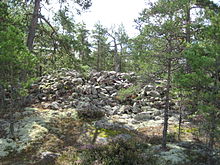
Eye from the late Iron Age near Godby, Finström municipality
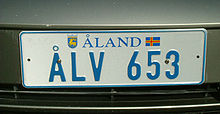
Car license plate from Åland
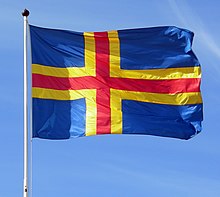
Flag Åland
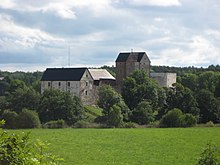
Kastelholm Castle on Åland was an important power factor in the Gulf of Bothnia in the Middle Ages.
Politics
Self-government
Åland is one of 19 counties (maakunta/landskap) in Finland, but its autonomous status gives it a special role. Åland's right to self-government is guaranteed in § 120 of the Constitution of Finland. The details are regulated in a separate Self-Government Act, which is in force today in the version of August 16, 1991 and is equal in rank to the Constitution. Åland has its own parliament, the Lagting 'Landtag', for decision-making in self-government matters, as well as its own county government. Parliament is elected by universal suffrage every four years. The Åland County Government (Ålands landskapsregering) is appointed by Parliament.
Parliament has legislative competence in matters falling under self-government. These matters include practically all regulations of internal administration, local economic life, social welfare and internal order. The Finnish state retains competence in foreign policy, most civil and criminal law, the organization of the courts, and customs and taxation matters.
The political parties operating in Åland are organizationally completely independent of the groupings operating in the rest of Finland. Election results of the last five elections:
| Party | Political orientation | 2019 | 2015 | 2011 | 2007 | 2003 | ||||||
| Share | Mandates | Share | Mandates | Share | Mandates | Share | Mandates | Share | Mandates | |||
| Åländsk Center (Åland Center) | social liberal | 27,94 % | 9 | 21,6 % | 7 | 23,6 % | 7 | 23,5 % | 08 | 24,1 % | 7 | |
| Liberals in Åland (Liberalerna på Åland) | liberal | 19,64 % | 6 | 23,3 % | 7 | 20,3 % | 6 | 31,6 % | 10 | 24,1 % | 7 | |
| Moderate Collection for Åland (Moderat Samling för Åland)1 | liberal, conservative | 13,82 % | 4 | 17,9 % | 5 | 13,9 % | 4 | 09,5 % | 03 | 13,6 % | 4 | |
| Unbound collection (Obunden Samling) | conservative, sovereignist | 13,57 % | 4 | 09,6 % | 3 | 12,6 % | 4 | 11,9 % | 04 | 09,4 % | 3 | |
| Ålands Social Democrats (Ålands Socialdemokrater) | social democratic | 09,10 % | 3 | 15,8 % | 5 | 18,5 % | 6 | 11,5 % | 03 | 19,0 % | 6 | |
| Sustainable initiative (Hållbart initiativ) | Green policy | 08,33 % | 2 | 00,8 % | 0 | - – | - – | - – | 0– | - – | - – | |
| Åland's Future (Ålands Framtid) | secessionist | 04,64 % | 1 | 07,4 % | 2 | 09,9 % | 3 | 08,1 % | 02 | 06,5 % | 2 | |
| Åland Democracy (Åländsk Demokrati) | national conservative, right-wing populist | 02,95 % | 1 | 03,6 % | 1 | - – | - – | - – | 0– | - – | - – | |
| Electoral Association for Henrik Appelqvist (Valmansförening för Henrik Appelqvist) | - – | - – | - – | - – | 01,1 % | 0 | - – | 0– | - – | - – | ||
| Sustainable Development Group (Gruppen för hållbar utveckling, abbr. HUT) | Sustainable development | - – | - – | - – | - – | - – | - – | 01,2 % | 00 | - – | - – | |
| Progress (Ålands Framstegsgrupp) | - – | - – | - – | - – | - – | - – | - – | 0– | 03,4 % | 1 | ||
1 in the 2011 election Moderaterna på Åland, until 2011 Frisinnad Samverkan
Åland is a member of the Nordic Council. On September 5, 2007, the Åland Document was adopted there, which is intended to give the autonomous territories of Åland, the Faroe Islands and Greenland equal membership in the Nordic Council.
Relationship with Finland
Åland, like all other parts of Finland, participates in the general elections held in Finland, in particular the elections to the Finnish Parliament and the European Parliament, as well as the direct election of the President. In the elections to the Finnish Parliament, Åland forms its own constituency. According to § 25 of the Finnish constitution, the autonomous archipelago is entitled to one of the 200 seats in parliament, regardless of population size. Regardless of party affiliation, Åland's representative in the Parliament of Finland regularly joins the parliamentary group of the Swedish People's Party. Since the 2015 election, Åland's seat has been held by Mats Löfström of the Åland Center.
The inhabitants of Åland are citizens of Finland. However, due to the Self-Government Act, there is a parallel so-called birthright (Hembygdsrätt), which is similar to an Åland nationality in its functions. Only persons with Åland birthright citizenship may actively and passively participate in elections to Parliament. The acquisition of real estate on the islands and the commencement of business activities also generally require Åland citizenship. Only Finnish citizens who have lived in Åland for at least five years without interruption and who speak Swedish can acquire Åland citizenship.
The liaison body between the national government and the autonomous region is the Åland delegation. The delegation is chaired by the governor (landshövding), who is appointed by the President of Finland in consultation with Parliament. The Finnish government and the Åland Parliament each send two additional members.
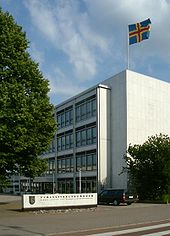
The most important organ of the Åland self-government is the Lagting (Parliament), which meets in this building in Mariehamn.
Administration breakdown
Åland consists of 16 municipalities. The capital and only city of Åland is Mariehamn. The archipelago municipality of Sottunga is the smallest municipality in Finland with 101 inhabitants.
|
|
The municipalities of Åland are grouped into three administrative communities (ekonomisk region). The municipalities on the main island, except for Mariehamn, belong to the community Ålands landsbygd (Ålands land), while the municipalities on the side islands belong to the community Ålands skärgård (Ålands archipelago). Mariehamn forms its own administrative community.
Economy
General
Åland is part of the European Union together with Finland. However, by virtue of Protocol No. 2 of the Treaty of Accession of Finland to the European Community, Åland is exempt from the application of the Community rules on the approximation of turnover taxes and excise duties. As a consequence, there is a tax border between Åland and the rest of the European Union, including mainland Finland. Shipments of goods to and from Åland must therefore go through customs clearance. However, because of the tax border, tax-free shopping is still possible when traveling from Finland or Sweden to Åland. The official currency is the euro, as in the rest of Finland, but in Åland it is often possible to pay with the Swedish krona.
The economy of Åland is characterized by a high ratio of small and medium-sized enterprises. There are about 2600 companies operating. Of these, about 700 belong to the traditional agricultural sector. About 90 percent of the companies employ fewer than ten workers. The unemployment rate has been very low for years and is often the lowest in Europe during the summer months. It was 2.0 percent at the end of September 2007. Because of the great importance of tourism, the labor market is partly characterized by summer seasonal jobs, which means that unemployment is regularly at its lowest during this period.
Transport and tourism
In addition to the traditional main industry of agriculture, tourism, especially ferry traffic, has risen to become the most important industry in Åland. Favored by the possibility of tax-free purchasing, shipping now produces 40 percent of Åland's gross national product. More workers are needed in this sector than are available on the Åland labor market. Therefore, many workers from Finland and Sweden are also employed on Åland ships.
In 2004, Åland was visited by 224,800 guests. Most guests came from Sweden with 111,400, the second largest group was Finland with 92,500 visitors, and in third place was Germany with 6700 guests.
Ferry service
From Helsinki, Turku, Stockholm or Tallinn the large ferries of the shipping companies Viking Line, Rederiaktiebolaget Eckerö and Tallink with Silja Line. There are also ferry connections to the Swedish towns of Kapellskär and Grisslehamn. From the Finnish side you can also get to Åland with the archipelago ferries from Osnäs, Kustavi and Galtby, Korpo operated by Ålandstrafiken. Ålandstrafiken also operates its ships between the islands of Åland.
Air traffic
Mariehamn Airport is located 3 km northwest of Mariehamn. Kumlinge airfield with a helipad is located in the Åland archipelago administrative community.
In 2005, under the auspices of the Åland Provincial Government and with broad support from Åland's business community, the airline Air Åland was established. In 2012, the airline ceased operations again and was taken over by Nextjet. On May 16, 2018, NextJet declared bankruptcy and ceased operations. The parts of Nextjet became Swedish Air Leap, which resumed operations at Mariehamn Airport in June 2018. There are regular connections from Mariehamn Airport to Helsinki-Vantaa, Stockholm and to Turku.
Road traffic
The islands have a dense road network with a total length of 912.7 km, of which 646.8 km are asphalted. In 2016, the motorization rate in Åland was 799 (passenger cars per 1000 inhabitants). Bus routes in Åland are operated by Ålandstrafiken.
Agriculture and forestry
The traditional agricultural trades have in recent times receded in importance behind the service sector, but continue to play an important role in Åland's economic life. In 2004, 5.3% of the workforce was employed in agriculture or forestry. The majority of Åland's industry, which employs 9.8% of the workforce, is also associated with the processing of agricultural and fishery products. Of Åland's land area, 9% is arable land, 4% is pasture land and 58% is forest.
The main products of Åland's agriculture are sugar beet (44,514 tons in 2004), potatoes (15,969 tons), onions (5669 tons), barley and oats (5597 tons), and wheat (4836 tons). The livestock sector is dominated by milk production (14,433 tons). The Åland fishermen brought in a total catch of 3300 tons in 2004, mainly herring (2541 tons). The 36 fish farms in the region produced a yield of 3210 tons in the same year.
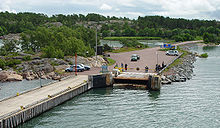
Small ferries operate in local traffic between the islands, here a mooring in Överö (Föglö).
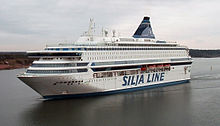
The large ferries operating between Stockholm and Turku, Helsinki or Tallinn dock in Mariehamn to allow tax-free sales on board. Here the Silja ferry Silja Europa.
Culture
Åland has a lively cultural life - measured by the number of inhabitants. This is primarily supported by private associations. Fifty of these associations are supported from the proceeds of the state (Åland) gambling company. Typical of Åland is the Midsommarstång - a tall pole erected in each village during the summer, resembling a maypole and decorated with ribbons in the colors of the Åland flag. The origin of this custom, which was first mentioned in writing in 1795, is unknown. Also typical for Åland are the numerous small windmills, of which about 100 are still preserved to this day - originally each farm had its own windmill.
Cultural life in Åland is further supported by the activities of the Nordic Åland Institute (Nordens Institut på Åland), an institution supported by the Nordic Council of Ministers for the promotion of Åland culture. Among other things, the institute has made possible numerous extensive theater productions in which both professional actors and amateurs have participated. The rural culture of the islands is presented in the open-air museum Jan Karlsgarden.
An important role in Åland's culture is played by the Åland Music Institute, which is home to around 300 students. There are also many choirs and music groups active in Åland outside the institute.
Architecture
The architecture of Åland has hardly any noteworthy peculiarities compared to Finnish and Swedish architecture. However, the density of old buildings, which is high by Finnish standards, is significant in terms of cultural history. Six fortified castles from the Iron Age have been preserved, the largest of which is the fortified castle of Borge in Finström. Since the archipelago was under the influence of the Swedish Empire early on, a large number of medieval buildings have been preserved on Åland. These include the archipelago's 13 fieldstone churches in addition to the 14th-century Kastelholm Castle, one of only seven castles in what is now Finland. Medieval church building began earlier on Åland than on the Finnish mainland. Thus, the church of Jomala, built between 1275 and 1285, is probably the oldest preserved building in Finland. The churches of Lemland, Sund, Hammarland, Saltvik and Eckerö reach a similar age. While the rest of the medieval stone churches in Finland are Gothic, the oldest churches in Åland still show Romanesque influences. Unlike on the Finnish mainland, the churches on Åland usually have a steeple, following the example of the country churches of Gotland. The interior of the churches is decorated with secco paintings, some of high artistic value.
Education
Åland has a well-developed education network. Each of the 16 municipalities has an elementary school, where students spend the first nine years of school and thus the entire period of compulsory education.
All secondary educational institutions, especially the upper secondary school, are concentrated in the capital Mariehamn. Mariehamn is also home to numerous vocational training programs. At the Åland University of Applied Sciences (Högskolan på Åland), students can earn various technical college degrees.
For more advanced university education, universities outside Åland must be sought out, with the vast majority of Åland students, about two-thirds, choosing Swedish universities.
Media
Two local daily newspapers are published in Åland. The slightly larger Tidningen Åland, founded in 1891 with a circulation of around 10,000 copies, was traditionally published on the five weekday afternoons until 2007, when it switched to morning publication and six weekly issues. The rival paper Nya Åland, which has existed since 1981, has always been published in the morning and also switched from five to six issues per week in 2007.
In 1984, the first Åland broadcasting company was established in Åland, Radio/TV Åland. Previously, Ålanders had only had access to Finnish state television and radio programs, which also broadcast Swedish-language programs, as well as programs from Sweden. Initially, Radio Åland began radio operations in 1984. Since the late 1990s, Steel FM, which is aimed primarily at younger people, and Soft FM have also become established. In addition, Swedish radio stations can also be received, some of which also offer their own local radio for Åland. Since October 2007, there have been two private television stations in Åland, TV Åland and Åland 24.
Sports
Like culture, popular sports in Åland are supported by funds from the state gaming company (PAF). About sixty sports clubs from all summer and winter sports are active on the islands. In addition, Åland participates in the Island Games. In the summer of 1991 and 2009, the Iceland Games were held in Åland.
In soccer, IFK Mariehamn has most recently caused a stir by being promoted to the top Finnish league (the Veikkausliiga, Swedish: Tipsligan) in 2004 and has managed to stay in the class ever since. In 2013 and 2016, the club even managed to qualify for the UEFA Europa League, but failed in the first round on both occasions. This success story has sparked a great deal of soccer enthusiasm in Åland. The Åland United women's team won the Finnish championship in 2009, 2013 and 2014.
Other Åland soccer clubs play partly in the lower-tier Finnish leagues and partly in Swedish leagues.
The largest soccer stadium and home of both IFK Mariehamn and Åland United is Idrottsparken, renamed Wiklöf Holding Arena in 2005. The new main stand, built in 2005/2006, has 1650 seats, with a total of 5637 seats and a 120-seat restaurant area. The stadium complies with UEFA requirements for international competitive matches and international matches.
Track and field athlete Janne Holmén was the 2002 European Marathon Champion for the Finnish team.
On December 13, 2008, first the men of the volleyball club Jomala IK, and one day later also the women, achieved promotion to the highest Swedish league "Allsvenskan".
Another popular sport is floorball (Swedish: Innebandy), which originated in Sweden. There are several Innebandy clubs and leagues on the island.

View of Hamnen, between Geta and Dånö
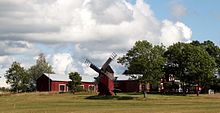
Windmill in Björsby, Jomala municipality
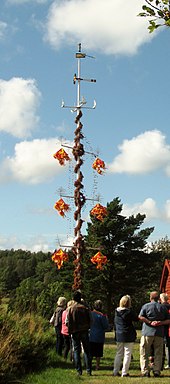
Midsommarstång at Kastelholm Castle in Sund
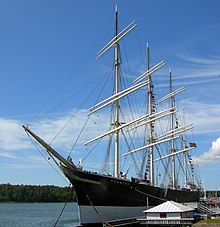
Sailing ship Pomerania in Mariehamn, today museum ship
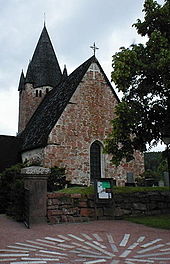
Finström church is one of the best preserved medieval churches in Åland.
Search within the encyclopedia
